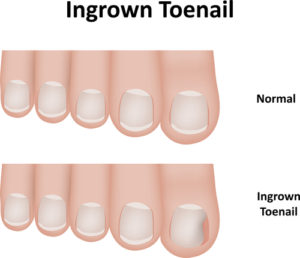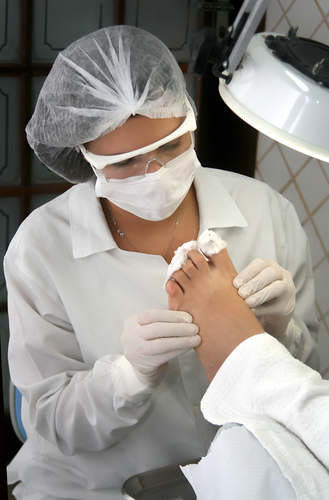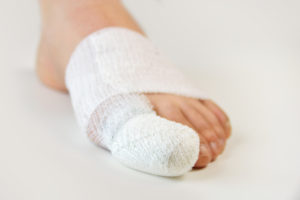Suffering from a sore toe? You believe your nail is the culprit? Greg Sterling Orthopaedics is here to inform you about ingrown toenails, the preventative treatments and the surgery involved if ingrown toenails reoccur or are infected.
What are in-growing toenails?
An ingrown toenail is classified as the edge of the nail digging into the skin fold besides the nail. The skin becomes red, hot, tender and swollen as a result of the nail in growing. Sometimes bacteria can get into the inflamed skin and an infection begins. An infection causes much more inflammation, which may spread throughout the toe or into the foot.
If infected, pus may also discharge from the edge of the nail. Infected ingrown toenails are usually settled with simple measures such as antibiotics and proper nail care. However, sometimes, it is a recurring problem.
What are my options?
The first option you have is to take preventative measures, hoping that the toenail will grow out and not be a problem again. This is always a good first step as sometimes an irregular activity, injury or bad toenail cutting led to the ingrown toenail, which means it may not happen again.
You need to be proactive with ingrown toenails, or ‘almost’ ingrown toenails. It is obvious when the side of your toe hurts. Do not ignore this pain, hoping it will disappear, sadly it often just escalates as the situation worsens.
Preventative Measures
Please note these preventative measures are not fail-safe solutions. They work for some people and not for others. However, they are worth trying if your toenail isn’t already excruciatingly painful or infected.
- Soaking your feet in hot, salty water. This prevents infection (very important), allows the skin and nail to soften, which releases some of the pressure on your toe.
- Putting anti-bacterial oils/creams or ointments onto the sore area (tea tree oil is great). Again, this just helps prevent infection.
- If your toe is beginning to develop an ingrown toenail (it’s not too sore to touch), then you can try lightly lifting the nail in the sore section. This will hurt a little bit, but sometimes lifting the nail is enough to prevent a full ingrown toenail. After soaking your foot is the best time to try this and you can also trim the nail section that was digging into your skin.
- The internet suggests cotton balls or Band-Aids to go between your skin and the nail digging in. If your toe is bad enough to try something like this, you should go to your GP instead. They will be able to assist in the preventative measures and prescribe medication where needed.
- If you have had an ingrown toenail once, you are likely to get one again. However, this isn’t a guarantee.
If you:
- Continuously get ingrown toenails.
- You’ve tried preventative methods.
- Seen your GP already about it.
- Have an infected toenail.
Then it’s time to ask your Brisbane GP for a referral. Booking a consultation at Greg Sterling Orthopaedics at St Andrew’s Hospital will allow a full assessment of your ingrown toenail and a plan moving forward.
Surgery
As per the information in our Toenail Ablation Surgery pdf, here are the fundamentals of the surgery Greg Sterling Orthopaedics performs to remove your ingrown toenail.
Toenail ablation surgery is a day surgery. This means you get omitted to the hospital, have the operation, then get discharged home, all on the same day.
Anaesthetics
The type of Anaesthetic used will be discussed with patients and decided on an individual case basis. Age of the patient, the severity of ingrown nail, whether an infection is present, prescription medications taken by the patient…are just some examples of the considerations taken when deciding which anaesthetic to use.
- Local: the toe will be injected with a local anaesthetic, which makes the entire toe go numb. This will take only a few minutes to take effect. You will still be able to feel the toe moving, but no pain. The surgeon always ensures that the anaesthetic is working before proceeding.
- General: involves being put to sleep. You will have an anaesthetist who puts you to sleep before the surgery commences.
Procedure
After the local anaesthetic is in effect (or under general) then the procedure is relatively straightforward.
- A small portion of the nail is removed.
- The underlying tissue from which the nail grows is exposed.
- A small section of this is removed to stop this part of the nail growing again. This is successful is 85% of patients.
- Occasionally, the entire nail needs to be removed. This is done by removing the entire section of the tissue underneath the toenail and requires cutting the skin at the corner of the nail.
Post-surgery & Recovery
Hospital
Following the surgery, the toenail will have dressings on it, that should not be disturbed. You can walk straight after surgery. However, you’ll need sandals/thongs/any open toed shoe to ensure no pressure is put on the bandage.
Home
At home, the foot will need to be elevated as much as possible for the first 7 days. Pain should be expected once the anaesthetic wears off. Simple Panadol should control the pain. The outer bandage can be removed after 2-3 days; however, the underlying dressing should not be disturbed.
Further Appointments
10-14 days after your operation, you will be seen in Dr Sterling’s rooms for a follow-up appointment. The dressings will be removed, and the toe inspected. The toe should be healed enough to allow normal shoe wear. The physiotherapist will be present during this appointment to help.








